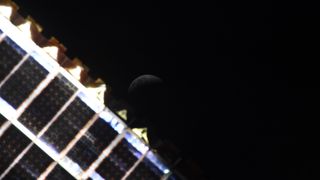Astronaut snaps Super Flower Blood Moon eclipse photos from space station

Astronauts at the International Space Station enjoyed stunning views of the total lunar eclipse on the night of May 15.
European astronaut Samantha Cristoforetti shared several snapshots on Twitter today (May 16), showing different stages of the Super Flower Blood Moon lunar eclipse framed by space station equipment and with cloud-covered Earth below.
"Were you lucky enough to be able to see the lunar eclipse last night? We were!" Cristoforetti wrote in one tweet.
Related: Amazing photos of the Super Flower Blood Moon of 2022

Looking for a telescope for the next lunar eclipse? We recommend the Celestron Astro Fi 102 as the top pick in our best beginner's telescope guide.
Because the International Space Station completes one orbit around Earth every 90 minutes, the astronauts probably enjoyed several rounds of the spectacle. The eclipse started on Sunday (May 15) at 9:32 p.m EDT (0132 GMT on May 16), when the moon entered the lighter part of Earth's shadow, called the penumbra, and finished more than five hours later when the moon exited the penumbra on the other side. The total eclipse phase, when the moon is completely covered by the umbra, the dark shadow of the planet, lasted for 85 minutes, the longest in 33 years.



During a total eclipse, the moon doesn't disappear from the sky but instead turns red, an effect caused by the scattering of light by Earth's atmosphere. This effect is responsible for the "blood moon" moniker that is frequently used to refer to the fully eclipsed moon.
Some of Cristoforetti's images show the darkened moon viewed through the space station's solar panels.
Get the Space.com Newsletter
Breaking space news, the latest updates on rocket launches, skywatching events and more!
"A partially eclipsed moon playing hide-and-seek with our solar panel," the astronaut wrote in another tweet.
Today's lunar eclipse was the first of 2022 and was best observed from the Americas, although skywatchers in western Africa and Europe also caught parts of the spectacle.
The next full lunar eclipse will take place on Nov. 8 and will peak above the Pacific Ocean, favoring skywatchers in the western United States, eastern Asia and Australia.
Follow Tereza Pultarova on Twitter @TerezaPultarova. Follow us on Twitter @Spacedotcom and on Facebook.
Join our Space Forums to keep talking space on the latest missions, night sky and more! And if you have a news tip, correction or comment, let us know at: community@space.com.

Tereza is a London-based science and technology journalist, aspiring fiction writer and amateur gymnast. Originally from Prague, the Czech Republic, she spent the first seven years of her career working as a reporter, script-writer and presenter for various TV programmes of the Czech Public Service Television. She later took a career break to pursue further education and added a Master's in Science from the International Space University, France, to her Bachelor's in Journalism and Master's in Cultural Anthropology from Prague's Charles University. She worked as a reporter at the Engineering and Technology magazine, freelanced for a range of publications including Live Science, Space.com, Professional Engineering, Via Satellite and Space News and served as a maternity cover science editor at the European Space Agency.